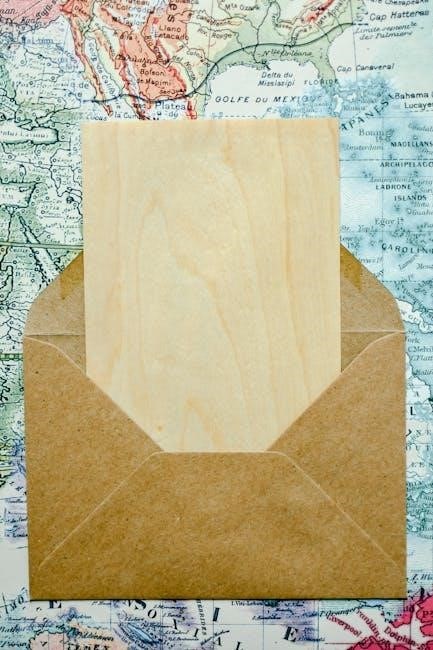The blank map of the 13 Colonies PDF is a versatile educational tool designed to help students and teachers explore early American geography and history. Featuring clear borders and unlabeled regions‚ it encourages interactive learning through labeling‚ coloring‚ and creative mapping activities. Perfect for classroom use or independent study‚ this resource fosters a deeper understanding of the original colonies’ layout and significance.
Historical Significance of the 13 Colonies
The 13 Colonies played a pivotal role in shaping the foundation of the United States. Established by British settlers‚ these colonies served as the birthplace of American democracy‚ culture‚ and identity. Each colony had distinct characteristics‚ from the agricultural focus of the Southern Colonies to the trade-oriented Middle Colonies and the religiously driven New England Colonies. The colonies’ diverse economies and cultural practices laid the groundwork for the nation’s future development. The blank map of the 13 Colonies PDF provides a visual tool to explore this history‚ helping students understand the geographical and historical context of America’s origins.

Importance of Blank Maps in Education
Blank maps are invaluable educational tools that promote active learning and engagement. They allow students to interact with historical and geographical content by labeling‚ coloring‚ and creating keys‚ which enhances retention and understanding. These maps encourage critical thinking and creativity‚ making complex concepts more accessible. By filling in details‚ students develop spatial awareness and a deeper connection to the subject matter. The blank map of the 13 Colonies PDF is particularly effective for teaching early American history‚ enabling students to visualize the colonies’ layout and their significance. Such resources are versatile‚ catering to various learning styles and educational settings‚ making them a valuable asset for both teachers and students.
Overview of the Blank Map of the 13 Colonies PDF
The Blank Map of the 13 Colonies PDF is a customizable educational resource designed to engage students in interactive learning. Available in both full-page and half-page formats‚ it features clear borders and unlabeled regions‚ allowing users to label colonies‚ color regions‚ and add details like a compass rose. The PDF is easy to download and print‚ making it a convenient tool for classrooms and personal study. It includes instructions for activities such as labeling colonies‚ coloring regional divisions‚ and creating a key‚ fostering a hands-on approach to understanding early American geography and history. This versatile resource is perfect for educators seeking to enhance their lessons with engaging and interactive content.

How to Use the Blank Map of the 13 Colonies PDF
The Blank Map of the 13 Colonies PDF is a versatile tool for educational activities‚ enabling students and teachers to engage in interactive learning through labeling‚ coloring‚ and mapping exercises.
Labeling the Colonies
Labeling the colonies on the blank map is an essential step for students to identify and memorize the names of the original 13 colonies. This activity helps students recognize the geographical layout and understand the historical context of each colony. Teachers can provide a list of colony names‚ such as Virginia‚ Massachusetts‚ and New York‚ for students to accurately label on the map. This exercise enhances geographical awareness and reinforces the connection between the colonies and their roles in American history. By labeling‚ students develop a visual understanding of the colonies’ locations and relationships‚ making it easier to study their cultural and economic differences. This interactive approach fosters engagement and retention of historical information.
Coloring the Regions
Coloring the regions on the blank map of the 13 colonies is a fun and educational activity that helps students visualize the geographical divisions. By assigning different colors to the New England‚ Middle‚ and Southern colonies‚ students can better understand the distinct characteristics of each region. This method also aids in identifying the colonies’ locations and their relationships with one another. Coloring fosters creativity and engagement‚ making history and geography more accessible. Teachers often encourage students to create a key or legend to explain the color coding‚ reinforcing their understanding of the colonies’ cultural and economic differences. This activity is both informative and enjoyable for learners of all ages.
Creating a Key for the Map
Creating a key for the blank map of the 13 colonies enhances understanding and organization. Students can use symbols or colors to differentiate between regions‚ such as the New England‚ Middle‚ and Southern colonies. The key should explain the meaning of each color or symbol‚ ensuring clarity. For example‚ a red box might represent New England colonies‚ while a blue box could signify Southern colonies. This activity encourages critical thinking and attention to detail‚ helping students connect visual elements to historical context. A well-designed key also serves as a reference‚ making the map more informative and user-friendly for educational purposes.
Adding a Compass Rose
Adding a compass rose to the blank map of the 13 colonies PDF is a simple yet effective way to enhance its educational value. A compass rose provides directional orientation‚ helping students understand the geographical layout of the colonies. Typically‚ it is drawn in a corner of the map‚ with arrows indicating north‚ south‚ east‚ and west. This activity teaches students about cartography basics while reinforcing their understanding of the colonies’ relative positions. The compass rose also adds a professional touch to the map‚ making it more visually appealing and functional for classroom use or historical projects.

Regions of the 13 Colonies

The 13 colonies are divided into three distinct regions: New England‚ Middle‚ and Southern. Each region has unique geographical and cultural characteristics‚ shaping early American history and development.
New England Colonies
The New England Colonies include Massachusetts‚ New Hampshire‚ Rhode Island‚ and Connecticut. Known for their rocky coastline and dense forests‚ these colonies focused on agriculture‚ trade‚ and fishing. Their tight-knit communities and shared cultural values played a significant role in early American history. The region is also notable for the Plymouth Colony‚ where the Mayflower landed‚ and the establishment of Harvard University‚ reflecting their emphasis on education and religion. This area laid the foundation for many of the principles that would shape the United States‚ making it a crucial part of the 13 colonies’ map.
Middle Colonies
The Middle Colonies‚ comprising Pennsylvania‚ New York‚ New Jersey‚ and Delaware‚ were characterized by their diverse economies and cultural influences. Known as the “breadbasket colonies‚” they thrived on agriculture‚ with fertile soil supporting crops like wheat and corn. These colonies also engaged in trade and industry‚ with cities like Philadelphia becoming hubs of commerce. The region’s diversity was further enriched by the presence of various European settlers‚ including Dutch and Quaker communities. The Middle Colonies played a pivotal role in early American history‚ serving as a bridge between the New England and Southern colonies. Their unique blend of cultures and economic activities makes them a fascinating subject for study on the blank map of the 13 colonies.
Southern Colonies
The Southern Colonies‚ including Virginia‚ Maryland‚ North Carolina‚ South Carolina‚ and Georgia‚ were primarily agricultural societies. These colonies relied heavily on cash crops like tobacco‚ rice‚ and indigo‚ which were cultivated on large plantations. The region’s economy depended on enslaved labor‚ shaping its social and cultural dynamics. The Southern Colonies also featured diverse geography‚ with vast coastal plains and fertile lands ideal for farming. Their distinct cultural identity‚ influenced by European settlers and enslaved Africans‚ played a significant role in shaping early American history. Studying the Southern Colonies on a blank map helps visualize their geographical and economic importance in the 13 colonies’ structure.
Downloading and Printing the Blank Map
The blank map of the 13 Colonies PDF is easy to download and print. Choose the correct paper size for optimal quality and clear details.
Steps to Download the PDF
To download the blank map of the 13 Colonies PDF‚ visit a reliable educational website and locate the resource. Click the “Download” button‚ select the desired PDF version from the dropdown menu‚ and save it to your device. Ensure you have a PDF reader installed to open the file. The map is designed for easy printing‚ allowing you to instantly access and use it for educational purposes. This straightforward process makes it convenient for teachers‚ students‚ and history enthusiasts to utilize the map for learning and research.
Printing Tips for the Best Quality
For optimal printing of the blank map of the 13 Colonies PDF‚ choose the correct paper size and orientation to ensure the map fits perfectly. Use high-quality print settings to maintain clarity and detail. Ensure the printer is aligned properly to avoid blurry or misaligned text. Select standard printer settings for best results‚ but adjust as needed for your specific printer. For larger maps‚ consider using legal or tabloid-sized paper. Always preview the layout before printing to confirm the map appears correctly. This ensures the final output is crisp and ready for educational use‚ whether for classroom activities or personal study.

Choosing the Right Paper Size
Selecting the appropriate paper size ensures the blank map of the 13 Colonies PDF prints clearly and fits your needs. For standard use‚ 8.5×11 inches (letter size) or A4 is ideal‚ providing a full-page layout. If you prefer a smaller version‚ choose half-page settings for concise printing. For larger maps‚ opt for legal or tabloid sizes to maintain detail without scaling. Ensure your printer settings match the selected paper size to avoid cropping or distortion. Preview the layout before printing to confirm the map appears correctly. This ensures the final output is crisp and ready for educational use‚ whether for classroom activities or personal study.

Educational Resources and Activities
Engage students with map scavenger hunts‚ interactive learning exercises‚ and integrating the blank map into lesson plans for a hands-on exploration of colonial history and geography.
Map Scavenger Hunts
A map scavenger hunt is an engaging activity where students locate and label the 13 colonies on a blank map. This interactive exercise fosters geographical awareness and historical understanding. Teachers can design hunts that include identifying colonies‚ oceans‚ and key landmarks. Students can work individually or in groups‚ enhancing collaboration and problem-solving skills. The activity can be tailored to different learning levels‚ with clues or riddles to make it more challenging. By incorporating historical facts or cultural details‚ scavenger hunts transform map work into a dynamic learning experience‚ making the study of the colonies both fun and educational for students of all ages.
Interactive Learning Exercises
Interactive learning exercises with the blank map of the 13 colonies PDF offer a hands-on approach to understanding early American geography. Students can engage in activities such as labeling colonies‚ coloring regions‚ and creating keys to differentiate between areas. These exercises encourage active participation and help students visualize historical boundaries. Teachers can assign tasks like matching colony names to locations or identifying regional patterns. Such exercises not only enhance spatial awareness but also reinforce historical context. By integrating these activities into lessons‚ educators can make learning about the 13 colonies both engaging and memorable for students of various learning styles and preferences.
Integrating the Map into Lesson Plans
Integrating the blank map of the 13 colonies PDF into lesson plans enhances historical and geographical understanding. Teachers can incorporate it into units on colonial history‚ using it as a visual aid to complement lectures or readings. Students can label colonies‚ color regions‚ and create keys‚ making lessons interactive and engaging. The map can also be used for assessments‚ such as identifying colonies or regions based on historical events. Additionally‚ it can serve as a starting point for discussions on the cultural and economic differences between colonies. By integrating the map‚ educators create a comprehensive and immersive learning experience that connects geography to history‚ fostering a deeper understanding of early America.

Historical Context of the 13 Colonies
The 13 Colonies were established by Britain on the eastern coast of America‚ serving as the foundation for early American history. They played a pivotal role in shaping the nation‚ leading to the American Revolution and the birth of the United States. The colonies’ diverse cultures‚ economies‚ and geographical layouts laid the groundwork for both cooperation and conflict‚ ultimately defining the course of American history.
Founding of the 13 Colonies
The 13 Colonies were established by Britain along the eastern coast of America between the early 17th and 18th centuries. Each colony was founded for distinct reasons‚ such as religious freedom‚ economic opportunities‚ or strategic military outposts. Virginia‚ the first successful colony‚ was established in 1607 for economic gain‚ while Massachusetts was founded by the Pilgrims in 1620 for religious freedom. Pennsylvania‚ founded by William Penn in 1682‚ became a haven for Quakers. These colonies developed unique cultures and economies‚ shaping their identities. The diverse founding principles and geographical layouts of the colonies laid the groundwork for their growth and eventual role in the American Revolution‚ ultimately becoming the first states of the United States.
Geographical Layout and Boundaries
The 13 Colonies were situated along the eastern coast of America‚ stretching from present-day Maine to Georgia. Their geographical layout was shaped by natural features like rivers‚ coastlines‚ and mountain ranges. The colonies were divided into three main regions: New England‚ Middle‚ and Southern‚ each with distinct geographical characteristics. Boundaries were often defined by colonial charters‚ treaties‚ and natural landmarks‚ sometimes leading to disputes. The diverse terrain influenced settlement patterns‚ economies‚ and cultural development. Understanding the geographical layout helps visualize how the colonies interacted and evolved‚ ultimately shaping early America’s development.
Cultural and Economic Differences
The 13 Colonies exhibited distinct cultural and economic differences‚ shaped by their geographical locations and historical backgrounds. New England colonies‚ such as Massachusetts‚ focused on trade and fishing‚ fostering tight-knit communities. The Middle Colonies‚ like Pennsylvania‚ became hubs for agriculture and diversity‚ attracting various ethnic groups. Southern colonies‚ including Virginia‚ relied heavily on cash crops like tobacco and rice‚ supported by large plantations. These economic variations influenced cultural practices‚ from labor systems to social structures. Understanding these differences helps highlight how the colonies developed unique identities while laying the groundwork for a unified American nation. This diversity is a key aspect of early American history.

Teaching Strategies with the Blank Map
The blank map of the 13 Colonies PDF enables interactive learning through activities like scavenger hunts‚ labeling‚ and coloring‚ fostering geographical awareness and creativity in students;
Encouraging Geographical Awareness
The blank map of the 13 Colonies PDF is an excellent tool for fostering geographical awareness among students. By labeling and coloring the colonies‚ students can visualize the layout of early America‚ understanding the spatial relationships between regions. This interactive approach helps learners identify the New England‚ Middle‚ and Southern colonies‚ reinforcing their knowledge of historical geography. The map also encourages students to recognize the significance of the Atlantic Ocean and the compass rose‚ essential elements for navigation and orientation. Such activities not only enhance spatial skills but also provide a hands-on way to explore the foundation of the United States.
Fostering Creativity Through Mapping
The blank map of the 13 Colonies PDF serves as a dynamic tool for fostering creativity in students. By allowing them to label colonies‚ color regions‚ and create keys‚ the map encourages personalized learning and artistic expression. Students can design their own visual representations of historical geography‚ making the learning process engaging and fun. This hands-on approach not only enhances creativity but also helps students develop a deeper connection to the material. The map’s flexibility allows educators to tailor activities to different learning styles‚ ensuring that every student can express their understanding in a unique and meaningful way. This creative engagement makes history more relatable and memorable.
Assessing Student Understanding
The blank map of the 13 Colonies PDF provides an effective way to assess student understanding of historical geography. Teachers can evaluate students’ ability to label colonies accurately‚ identify regions‚ and create keys. The map serves as a visual assessment tool‚ allowing educators to gauge comprehension of the colonies’ layout and boundaries. By reviewing completed maps‚ teachers can identify areas where students may need additional support. This hands-on approach ensures that students not only retain information but also demonstrate their knowledge in a clear and organized manner. The map’s simplicity makes it an ideal resource for formative and summative assessments in the classroom.

Additional Tools and Worksheets
Complement the blank map of the 13 Colonies PDF with worksheets‚ online map games‚ and grading tools. These resources enhance learning and provide comprehensive assessment options for students.
Complementary Worksheets for Colonies
Enhance learning with complementary worksheets for colonies that pair perfectly with the blank map of the 13 Colonies PDF. These worksheets include activities such as labeling colonies‚ coloring regions‚ and creating keys. They also feature exercises for writing colony names and understanding historical context. Designed for various grade levels‚ these resources support interactive and engaging lessons. Teachers can integrate them into broader lesson plans‚ while students benefit from hands-on practice. The worksheets are ideal for reinforcing geographical and historical knowledge‚ making them a valuable addition to any curriculum focused on early American history and geography.
Online Map Games for Practice
Supplement your learning with online map games for practice‚ designed to complement the blank map of the 13 Colonies PDF. These interactive tools offer engaging ways to test knowledge of colonial geography. Features include quizzes‚ drag-and-drop activities‚ and virtual scavenger hunts that challenge students to identify colonies and regions. Many games are web-based‚ making them accessible for classroom or home use. They cater to different learning styles and provide immediate feedback‚ helping students track their progress. These resources are ideal for reinforcing lessons and making history and geography fun and competitive. They align perfectly with the blank map PDF for a well-rounded educational experience.
Grading and Feedback Techniques
Effective grading and feedback techniques are essential when using the blank map of the 13 Colonies PDF in educational settings. Teachers can use rubrics to assess accuracy in labeling‚ coloring‚ and key creation. Providing constructive feedback helps students improve their geographical knowledge and understanding of historical context. Digital tools can streamline grading‚ while handwritten comments offer personalized insights. Clear criteria ensure consistency‚ and allowing revisions fosters a growth mindset. Feedback should highlight strengths and areas for improvement‚ making the learning process engaging and productive for students of all skill levels. This approach enhances retention and encourages academic growth.
The blank map of the 13 Colonies PDF is a valuable tool for enhancing historical and geographical learning. Its versatility and educational benefits make it a must-have resource for engaging students and fostering a deeper understanding of early American history.
Final Thoughts on the Blank Map of the 13 Colonies PDF
The blank map of the 13 Colonies PDF is an invaluable resource for educators and students alike‚ offering a hands-on approach to learning early American history and geography. Its simplicity allows for customization‚ making it adaptable to various teaching methods and student needs. By enabling activities such as labeling‚ coloring‚ and creating keys‚ the map fosters engagement and understanding of the colonies’ layout and significance. Available in multiple formats‚ it is easily accessible and printable‚ ensuring convenience for both classroom and home use. This tool not only enhances learning but also encourages creativity and critical thinking‚ making it a must-have for history enthusiasts and educators seeking interactive and effective teaching aids.
Encouragement for Further Exploration
Exploring the blank map of the 13 Colonies PDF is just the beginning of a fascinating journey into American history. Encourage students to delve deeper by researching the unique characteristics of each colony‚ such as their economies‚ cultures‚ and roles in the Revolution. Pair the map with timelines‚ biographies‚ and primary sources to create a comprehensive learning experience. Interactive activities like map scavenger hunts and online games can further enhance engagement. By fostering curiosity and creativity‚ this resource inspires students to connect with the past and appreciate the foundation of the United States. Make history come alive with this versatile and educational tool!

Leave a Reply
You must be logged in to post a comment.